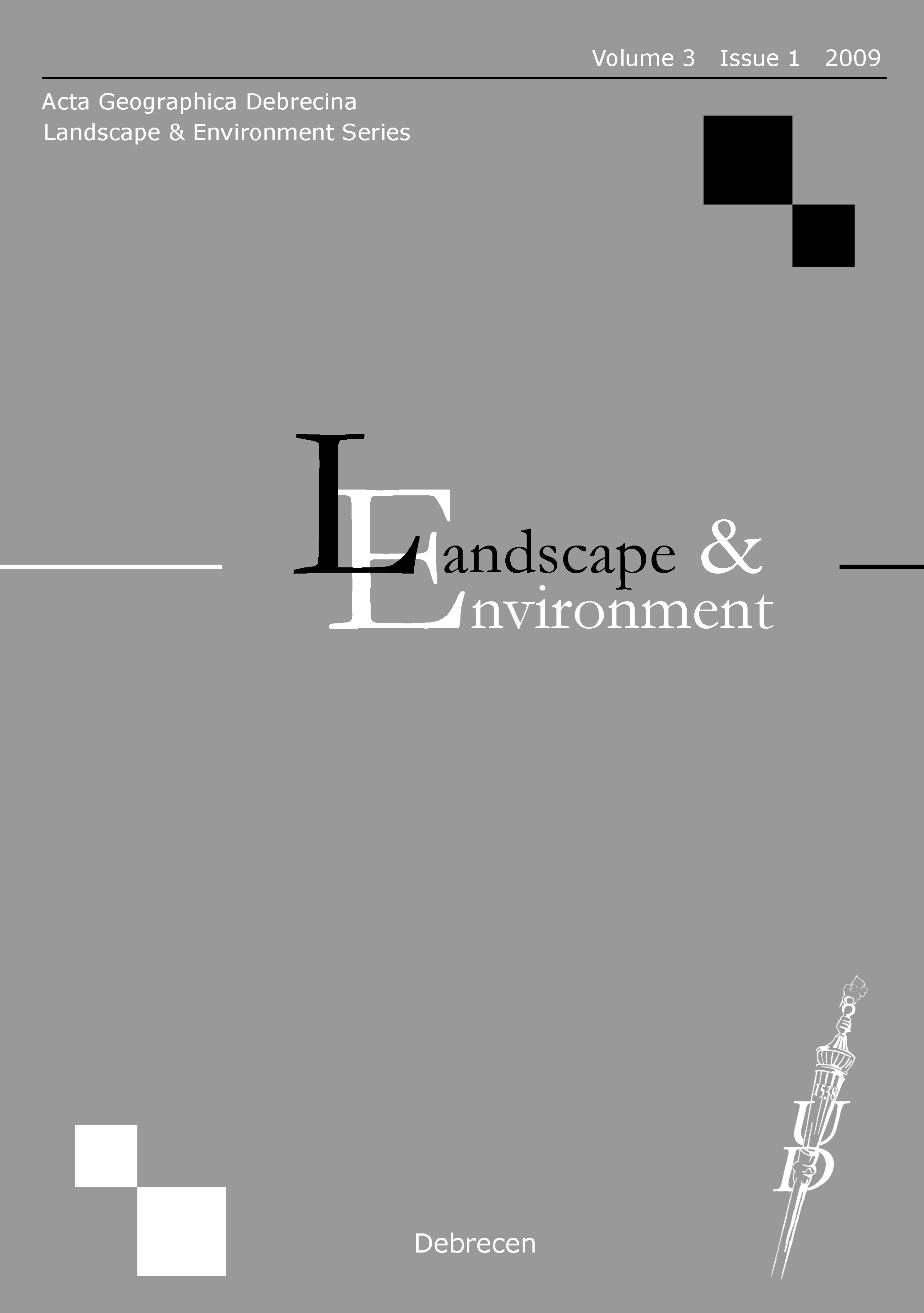Vol. 3 No. 1 (2009)
Kiss, T. - Sándor, A.: Land use changes and their effect on floodplain aggradation along the Middle-Tisza River, Hungary
Farsang, A. - Puskás, I. - Szolnoki, Zs.: Human health risk assessment: a case study of heavy metal contamination of garden soils in Szeged
Mecser, N. - Demeter, G. - Szabó, G.: Morphometric changes of the River Bodrog from the late 18th century to 2006
Demeter, G.: Measuring connectivity - A new approach for the geometrization of the landscape and for the enhancement of cost-effectiveness in landuse planning
##issue.tableOfContents##
Articles
-
Land use changes and their effect on floodplain aggradation along the Middle-Tisza River, Hungary
1-10Views:153Land-use changes and their effect on overbank sediment accumulation were investigated on the floodplain of Middle-Tisza River. Military survey maps (1783, 1860, 1883 and 1890) and aerial photos (1950, 1965, 1980 and 2000) were used to evaluate land-use changes and to calculate the vegetational roughness of the area. To determinate the rate of overbank sedimentation sediment samples were collected from a pit, the grain-size, content of organic matter, heavy metal content (Pb, Cu, Zn, Ni and Cd) and pH were measured. Until 1950 meadows and pastures were typical on the floodplain, gallery-forest was along the river, the oxbow-lake and the artificial levee. Notable landuse changes were detected in the second half of the 20th century, as the aerial photo taken in 1965 shows extensive forestry in the area. These land-use changes affected the average vegetational roughness, as it has been doubled since the disappearance of grasslands. Land-use changes highly affect the aggradation, as the increased roughness decreases the flood velocity on the floodplain, causing accelerated aggradation. Using Pb marker horizons and grain-size changes the studied sediment profile was compared to dated profiles (Braun et al. 2003), thus, the sediment accumulation rate could be determined for the periods of 1858-1965 and 1965-2005. According to our measurements the accumulation rate was doubled since 1965, very likely in connection with the doubled vegetational roughness.
pdf170 -
Human health risk assessment: a case study of heavy metal contamination of garden soils in Szeged
11-27Views:139The soils of the big cities, owing to the various anthropogenic activities, can be contaminated by heavy metals. The surroundings of the roads with heavy traffic as significant metal emitter source can be contaminated by heavy metals. The hobby gardens and the vegetable gardens directly along roads can be potential risky for people since unknown amount of heavy metals can be accumulated into organization of local residents due to consumption of vegetables and fruits grown in their own garden. Most metals are well-known to have toxic characters but we have known little what extent these metals exert influence on people living directly along road with busy traffic. During our research, metal contamination has been investigated in the gardens near the roads with heavy traffic in Szeged by measuring of metal contents in soil and plants samples. Enrichment factor has been calculated with the help of control soil samples far from roads having heavily traffic. Besides determination of the metal content of soil and plant samples, soil properties basically influencing on metal mobility has been examined in order to characterize the buffering capacity of the studied soils. The health risk quotients have also been determined to evaluate human health risk of the contaminated soils.
pdf69 -
Morphometric changes of the River Bodrog from the late 18th century to 2006
28-40Views:170The river regulations of the 19th century have affected each of our rivers to a different degree. In the case of the River Bodrog it was stronger than the average. In our paper a section of the river between Bodroghalász and Szegi was examined, the extent and intensity of river channel changes was intended to be determined. The applied series of maps and aerial photos was georeferred and the river channel was vectorized. The morphometric parameters of the channel were measured and the changes were evaluated using the created database. From methodological aspect we concluded that the 9 variables can be grouped into 3 factors therefore most of the indexes can be substituted. We measured the changes of length and lateral shift of the channel using GIS methods. Three development periods were identified based on our results. In the first period the development of the river was characterized by natural processes. Then, the development of the river altered owing to the antropogenic impacts. In this transient phase the average shifting of the channel was 7.43 m/y. In the third term this value reduces to 0.2 m/y as the river is getting to reach the equilibrium stage.
pdf53 -
Measuring connectivity - A new approach for the geometrization of the landscape and for the enhancement of cost-effectiveness in landuse planning
41-55Views:123The study aims to introduce a new method and approach for measuring the diversity of connectivity with the help of the landscape geometrization, in order to create a new variable useful in landscape metrics and to decrease the costs of landscape planning if its main goal is the enhancement of connectivity. Using induction we identify the landscape elements with geometric elements, calculating the theoretical maximum line, section, intersection point (node) number and compare these values of the idealistic landscape to the values of the real landscape.
pdf70
